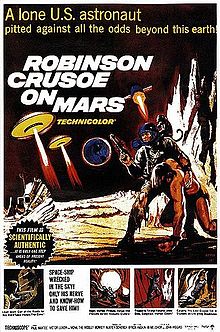
ROBINSON CRUSOE ON MARS
US, 1964, 110 minutes, Colour.
Paul Mantee, Victor London, Adam West.
Directed by Byron Haskin.
Robinson Crusoe on Mars, as the title suggests, is an adaptation of Daniel Defoe’s classic novel to space. Two astronauts go into space, Adam West and Paul Mantee. Mantee’s character has to eject and is accompanied only by a monkey. He has to work out how to survive on Mars finding air, water, food. Halfway through a character, Friday, an alien, appears who works with the Robinson Crusoe character to survive.
Audiences who know the novel and the original story will find the comparisons interesting. Those interested in science fiction, especially as it developed from the rather rudimentary films of the 1950s to some more sophistication of the 1960s (2001 was only four years off), will be able to make entertaining comparisons.
The film was directed by special effects expert, Byron Haskin, who moved into direction in the late 40s and made, amongst other films, the classic Treasure Island as well as its sequel Long John Silver. At the time of making this film, he was also making episodes of The Outer Limits for television.
1. How do audiences respond to science fiction films? What presuppositions about the human race, goals of life, scientific know-how do science fiction films have? Why do they captivate audience interest? that insight into human nature do they give? How did this film square with these presuppositions?
2. Comment on the technical detail of the film, the use of colour and wide screen, the space vehicles and their apparatus, Hare, the landscapes, the fire and ice, the man confronting the Martian landscape? How impressive was this, how realistic?
3. What special features of science fiction did the film emphasise? How well did it use them? How well did it explore the fantasies about other worlds? About survival in other worlds? How much imagination went into the film?
4. Was it necessary for the audience to know the Robinson Crusoe story? Did the impact of the story and its message come without knowledge of the original? How valuable was knowledge of the original? How well were the parallels drawn? Where did they differ? Were they sufficiently updated to be credible? What does this say about the perennial nature of the story?
5. How important was the theme of survival? desperate need to lives to survive, not to give up, for air, food and water, companionship, searching?
6. How interesting a film on exploration was this? How interesting a film on modern science? How valuable a film of the human imagination about Mars?
7. What did the film have to say about human enterprise and space exploration, avoiding missiles in space, the landing, the way of survival, exploration? How noble are people in their enterprises?
8. How well did the film portray basic needs and their fulfilment, the discovery of oxygen, the monkey leading to water and food, the search for companionship, the reverence in the burial, the joy of the companionship, the rescue of a friend from enemies?
9. Was the character of Draper well drawn? In the initial explorations in his American background, his coping with survival, his relationships with Friday? The importance of his device for talking into the tape recorder? What insight into his character did these sequences give? Was he an Everyman figure?
10. The importance of the role of the monkey in the film? Sentimental or realistic, humorous? Worked into the plot for survival?
11. How convincing was the Friday parallel? The slave and friend, the bonds of rescue between the two, communication and language, the threat of enemies, the escape?
12. How interesting were the adventures? How exciting? The hostile attacks of the planes, the underwater caves, the icecap, the heat and the fireballs?
14. For whom was the film made? How appealing to audiences of all ages? The range of interest? A classic science fiction film?